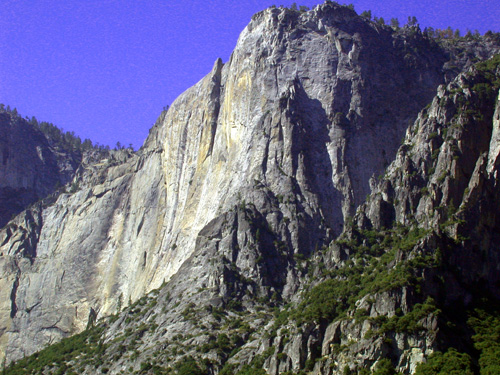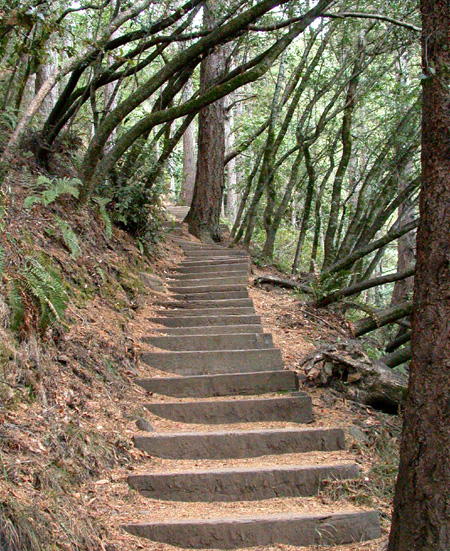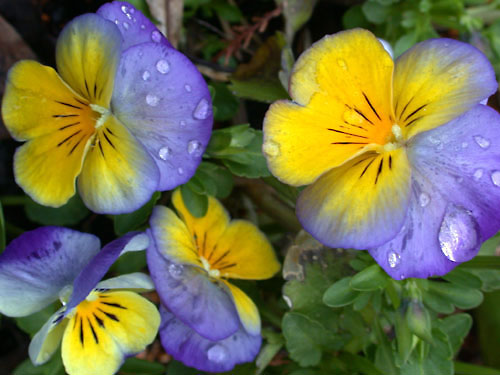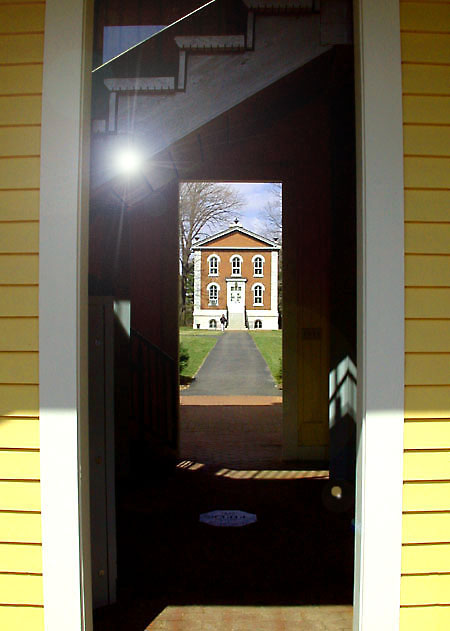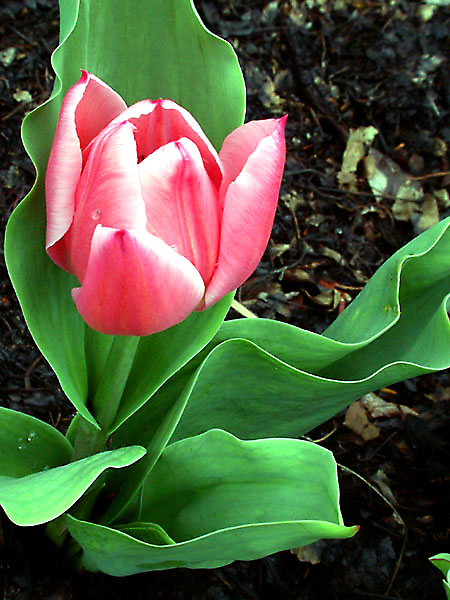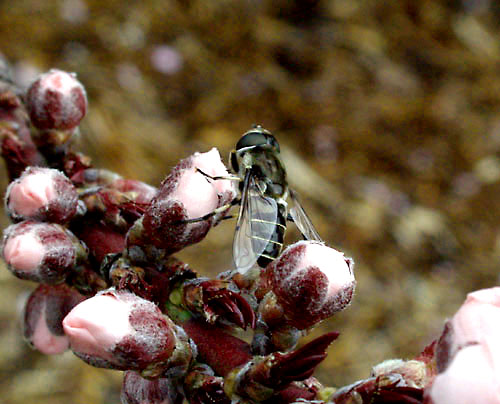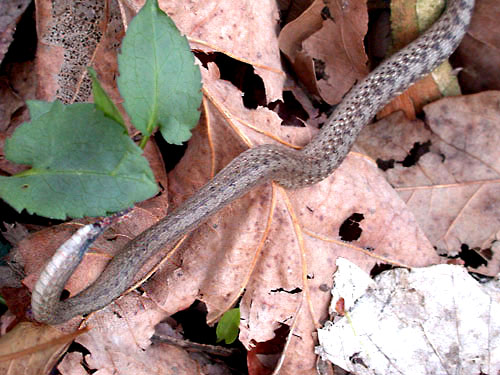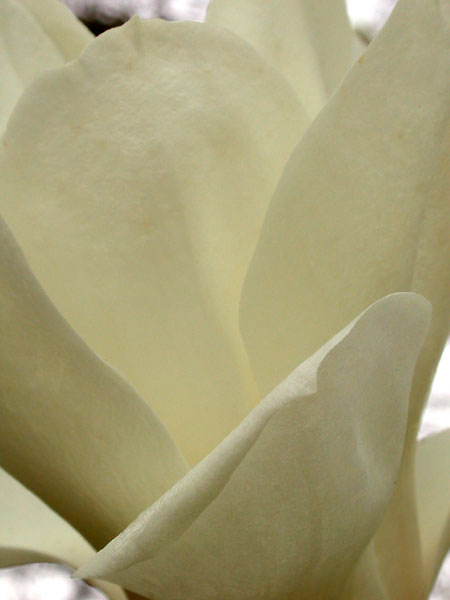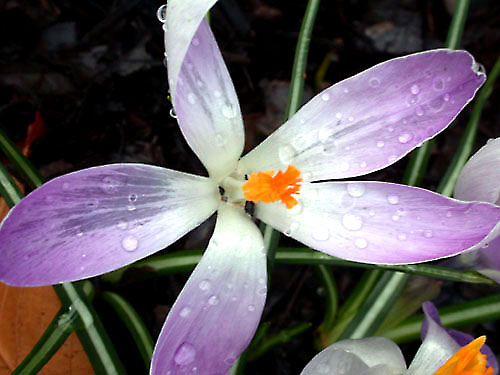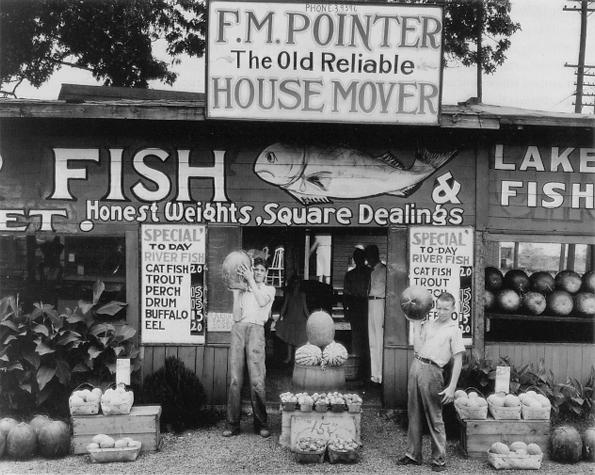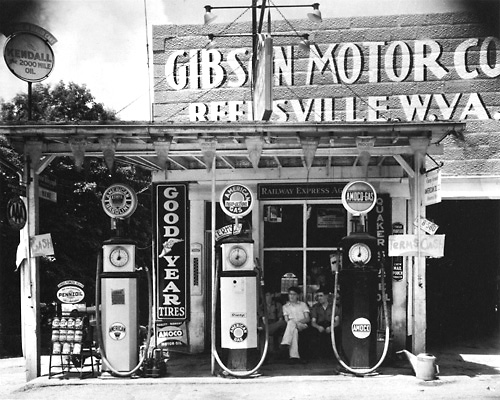Recovered from the Wayback Machine.
When I started this weblog three years ago, it was a continuation of my web site that I’ve had since 1995. As such, it focused primarily on technology, with an occasional aside into science or art or literature. I started with a free Manila-based weblog hosted by Userland, which was removed sometime last year, probably because it hadn’t been updated for so long. I regret now that I didn’t copy some of the entries, but not too much because I didn’t really write anything special during that time.
In my first few months, I rarely wrote just to write, to be a writer; I was intimidated by the medium. Unlike my other writing, in articles and books and online, weblogging lacked abstraction. I could view the statistics and watch the numbers of readers rise and fall and realized that there was a core of readers who would come by daily who didn’t do so because they followed a link to a tutorial or found a page from a search engine – they were returning to read me, and I didn’t know who they were.
It became a game with me to write a few posts in a certain manner or on certain topics and then watch the statistics to see if my readership would increase or fall off. I wasn’t writing, though I was using words to the best of my ability; I was fishing, and trying different bait. Moreso, I was trying to carve my space into a small audience amidst others who were famous (at least within this subculture), or very talented, and occasionally both.
Among these others, the first weblogger I started reading was Dave Winer, but I eventually connected up with the Cluetrain gang through the writings of Chris Locke, otherwise known as Rageboy. This was back before 9/11, the event that sent Americans scrambling for guns under their beds, flags to hang from their trucks, and made weblogging what it is today. (At least, until some other pivotal moment that will make weblogging what it is today, tomorrow.)
Back then, in 2001 we were trying to understand what weblogs were, and to me, they were all about the writing. I wrote the following, till preserved at Rageboy’s site:
Within these things called weblogs there are gems of creativity and brilliance that take my breath away. There’s writing that’s so good that I feel gifted with the words.
Sometimes the people who write the weblogs are known; most of the time, they aren’t. Doesn’t matter, though. All that should matter is the writing. It’s the words that count – everything else is just fluff, sparkle, and zazz.
That was in November of 2001 during the time of the infamous Blogmatch between Winer and Locke, which focused on the question of that time: what is a weblog. Winer said that …weblogs are rational writing, that’s why it’s so close, if you’re serious about it, to academic writing. To which Locke responds with:
There are two things I want most in life. The first is to be taken seriously. The second is to be mistaken for an academic. No wait, there are three. The third is to set my hair on fire.
Today Dave Winer works for Harvard and hosts BloggerCons and talks about weblogs and politics; while Chris Locke paints posts with pictures, some naughty, some nice, about narcissim and new age cranks, pulling words reluctantly from the page like a fisherman heaves fish, line caught and fighting, into a boat. (And Voidstar preserved the Blogmatch, to which we owe him, “Thanks”. )
Through Chris I was introduced to another Chris, otherwise known as Stavors the Wonder Chicken. Today Chris/Stavros appears in an Empty Bottle but back then it was Waeguk Wasn’t Soup.:
I don’t beat small children senseless, although I have been known to swallow them whole when they cross my bridge without permission.
I should clarify what is no doubt an overwhelming impression that I hate Korea. I don’t. Well, sometimes I do, goddamnit, but it’s more complicated than that. I do hate the chaos, the filth, the racism and casual cruelty, but there are scores of Korean people I just love to bits. I live in hell. My Liver is a big, misshapen bubbly fat-encrusted abomination that keeps functioning through sheer power of will I’m grumpy. Old Korean men – fuck, how I hate them with a white-hot eye-popping passion. I’ve got no problem with people eating dogs, if they want to. Shit, I’ve done it.
I’m afraid I’ve walked through the portal into bizarro-world.
Sometimes, my mind reels. Other times it just kinda sashays around, coyly. Sometimes I surprise myself. I don’t fucking know.That’s cool with me. I’m pure misanthrope, with enough scorn to go around for all of humanity. At the same time, love love love. It’s weird being me.
As Chris Locke would say, What a pleasure to read good writing once in a while, even if it does make you want to puke.
(Others concur because our Chicken is now destined for fame and glory, and it behooves us to toddle on over to his place and put in links to our favorite ravings from that grumpy old man with the pickled liver who doesn’t swallow children whole.)
What are weblogs is a question that keeps re-appearing over time, and as new webloggers come along who begin to question the format and all the written and unwritten rules. The issue of what is a weblog splits into two major categories: what makes a proper weblog, and what makes a proper weblogger. Over the last three years, I’ve watched both being defined and redefined again and again, and have spent, as I look back now, an inordinate amount of time defending weblogs against proper weblogging etiquette and form and webloggers from being classified as everything from political activists to citizen journalists.
The question of weblog form has resurfaced again this week, when Eric Meyer of CSS fame wrote that Weblogs are temporarily broken. He based this posting on the reverse chronological order of our front pages, and started a conversation carried by other webloggers including an odd one by Scoble about just wanting to know that the rabbit was eaten being good enough.
The proper form for a weblog was a large topic of discussion once long ago based on an article that Meg Hourihan wrote for O’Reilly titled What We’re Doing When We Blog. In it, Meg started out promisingly with the following, in response to American Journalism Review article:
In her article, Catherine forgoes the more traditional weblogs-are-links-plus-commentary definition to carve out a new meaning for the word, limited to the type of blogs she reads. But Catherine’s analysis misses some of the very subtleties that distinguish weblogs from other writing. Rather than rant that Catherine just “doesn’t get it,” it seems to me that her article, and others that are similar, are perfect opportunities for the blogging community to talk about our own evolution.
But then wrote:
If we look beneath the content of weblogs, we can observe the common ground all bloggers share – the format. The weblog format provides a framework for our universal blog experiences, enabling the social interactions we associate with blogging. Without it, there is no differentiation between the myriad content produced for the Web.
The article received almost universal acclaim, but I wasn’t one of the admiring crowd. I wrote a critical essay but then I pulled it based on some misplaced sense of honor, which I’ve since shed – not the honor, but that honor could be misplaced. However, others also responded including Stavros, (and here), Jonathon Delacour, and Jeff Ward.
Stavros wrote:
How tedious is this, how perfunctory and lacking of any sense of the mad, wild spirit of creativity that is tearing through the souls of (fill in the names or pseudonyms of your favorite bloggers here)? Sorry, Meg, but this piece strikes me as soulless, by-the-numbers, and regrettably keen to dumb things down as much as possible, custom-designed for Big Media to understand and quote it. Calculated to be Just what the Market Wants.
Like me and Stavros, Jonathon Delacour was also struck by the reduction of weblogging to the format, writing in a post (that’s since been pulled from his active archive, proving yet again that old posts never fade away, as long as they live in the memories of your readers–dammit):
Just like those photo-technicians, Meg Hourihan defines blogging in terms of the format: reverse-chronological and time-stamped. In this sterile depiction, the key elements of a blogging post are the links, the time-stamp, and the permalink.
God give me strength. I could describe a Walker Evans photograph by saying that it was taken with a Zeiss Protar lens on a tripod-mounted 8 x 10 Deardorff view camera, at f/45 to maximize the depth of field and with a G filter to emphasize the clouds. All of which is true but, frankly, who gives a shit? Such a description refuses to acknowledge that Evans’ image of a highway corner in Reedsville, West Virginia in 1936 is not just visually complex and gorgeous to look at. Evans’ radical approach to picture-making subverted many of his contemporaries- most deeply ingrained beliefs about pictorial beauty and the purpose of documentary photography.
Which is not to say there’s no place for an explanation of the mechanics of weblogging: tools, posts, links, time-stamps, permalinks. But wouldn’t it be better to leave those prosaic details for later? And to start by mapping out an imaginative vision of the medium’s potential?
Jeff Ward, though, likened weblogging format to a grammar, which in the end fosters a new form of communication. Returning to Jonathon’s photography analogy, Jeff wrote:
The technology of photography is indeed of great importance, for example, in examining how the small hand-held camera and high speed films fundamentally changed the content of photography. In a mature medium, these questions are less important. But still, Walker Evans’s nearly recursive move back into heavy view cameras deeply effected the character of the images he produced, when contrasted to his street photography with roll-film cameras. The grammar of the machine affects the content. I gave up infrared photography largely for the reasons Jonathon suggested; people didn’t care about the photographs, only the technology. But, how old is blogging? Shouldn’t we be asking precisely these sort of questions?
Weblog as format continued to surface from time to time in other contexts. There is the issue of the long-format webloggers as compared to the linkers (the link/comment blogging), and what is or is not “good weblog writing”. Halley Suitt recently discussed this:
With a new project I’m working on, I am teaching some non-bloggers how to blog and it’s really interesting to show someone the ropes. I have a whole different attitude about blogging than I used to.
For instance, I think brevity is the soul of blog wit more than ever. Look at my archives and see some of my first year’s worth of posts – too too long and ponderous I think.
Short and sweet – the best blog is a fresh blog full of lots of little posts.
Halley did not get universal agreement for her ’short and sweet’ assertion, and she would later point out examples of longer writing that she felt were acceptable. However, if you ask many old time webloggers what a weblog post is, they’ll say it’s a link to something interesting, with a short comment, no matter how many of us fill pages and pages with writing (causing all sorts of havoc with weblog tools finetuned for links and blurbs).
How much we syndicate is another issue of format that has occupied much of our writing. In this case of proper weblogging format those of us who provide excerpts in our syndication feeds are pushed to provide full feeds. The reason is that others who link to hundreds, thousands, of webloggers can then read many thoughts at a single gulp, disregarding carefully maintained weblog appearances, thoughtfully crafted writing, and how can one differentiate so many voices compressed into one simple aggregator.
Or as I wrote in The Gluttony of Information:
Rather than fight information overload, give in to it. Embrace it. Accept complete saturation as nothing less than that which is to be achieved. Apply the same practices to our consumption of information as we’ve applied to food and consumer goods and foreign policy, because we can never have too much.
After all this reading about RSS today, I finally get it. I finally understand the magic:
RSS is the both the McDonald’s and Wal-Mart of data”
(And then there’s the topic of RSS 2.0 and RSS 1.0 and RSS 2.0 and Atom. I have so many writings on these that I can’t link to all of them – you can just search on Atom to get a feel for how much this has impacted on my writing. What would we write about, if we didn’t have RSS and Atom?)
Proper form, short and sweet, aggregated and conjoined: sometimes the demands of the weblogging medium have grown so large, and the format so important that I’m reminded of a time my mother received a present for Christmas one year that was beautifully wrapped. It had gorgeous paper and an intricate paper flower surrounded by glittery ribbons of many colors. After opening it and seeing what was inside, some silly knick knack, she laughed and said, “I think I’ll toss the gift and keep the box”.
I wrote the following April, 2002, in a post titled My Weblog has Fallen Down:
A weblogger’s nightmare:
I am looking at a weblog page with a Google box to the right and a NY Times box to the left and several buttons with coffee mugs all over them that generate OPML, RSS, and various other assorted and sundry XML flavors. Within the page there is this outline with links and plus signs and you click on the plus signs and the content is expanded to show even more outlines, which can expand to even more outlines, and on and on and on.
And I see myself hunting desperately through the page knowing if I look hard enough, deep enough, I will find the truth. I will find what the weblogger has to say.
Finally, after I click enough of the little plus signs, and get rid of all these boxes that keep opening up and tell Google to shut the fuck up for just one second, I find it.
Hear the words of The Weblogger:
You are The Doc Searls Weblog!
You are located at http://doc.weblogs.com/You are rather jolly. You write a lot of geeky stuff. You are so fond of penguins that you edit a journal about them.
At which point my head implodes from one mind bomb too many, and the weblog falls over and the Internet gets sucked up into this huge black hole and the universe as we know it ceases to exist.
What is a proper weblog. Might as well ask, what is proper writing and hope to find a universal answer that will satisfy everyone. Or as I wrote wrote in April, 2002:
We’ll never know what is or is not good weblog writing, because the writing is as unique as the number of writers, as good as the worst of us and as poor as the best. We define the rules and we can break the rules, and the first rule we break is to throw out all our assumptions about ‘what is good writing’.

